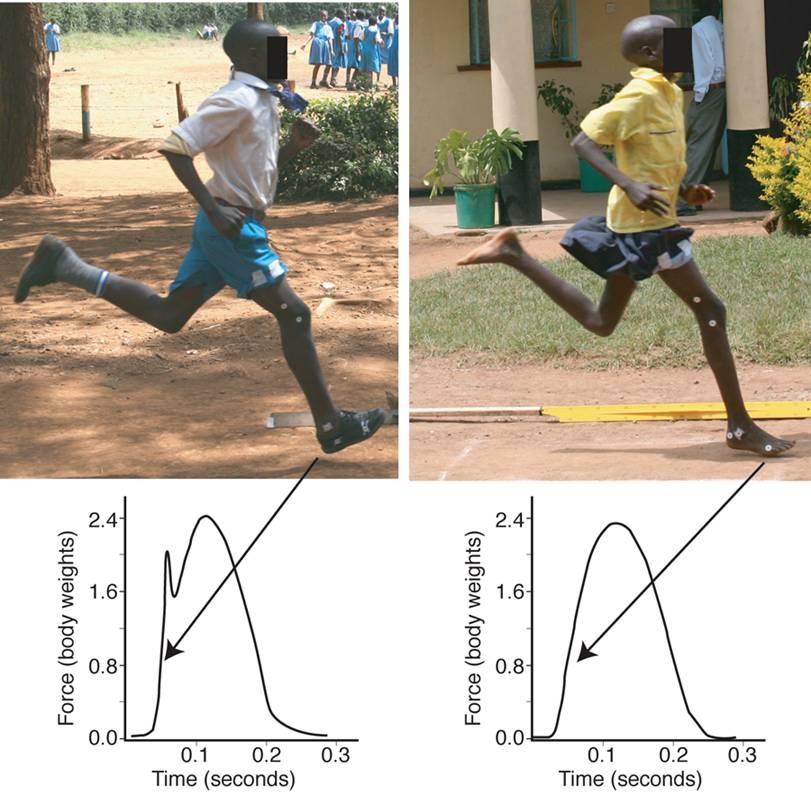This is brilliant. I’ve heard intimations of it on various websites for the last few months, but it’s always good to see a published paper backing it up.
In short, it says that running shoes are not actually necessary for runners. In fact, they may do more to cause damage than to protect.
So, the paper, published in Nature, says something along the following lines:
Man has evolved as a creature capable of running. For long distances, on often very hard (and by that I mean the opposite of squishy) terrain. If you don’t believe me, simply look at the runners in, well, large parts of Africa.
People running barefoot generally land one of two ways - either on the front/balls of their feet, or else using a ‘mid-foot strike’ in which both ball and heel land simultaneously. This allows the complex feat of structural engineering that is the human body to absorb most of the shock of this impact - the moment when, apparently, running can cause the most injury.
However, running shoes change the gait of a runner substantially. By lifting and cushioning the heel, they elongate a runner’s stride, meaning that the impact of striking is the ground is borne by the runner’s heel. and then ricochets upward. This, in turn, leads to a huge amount of jarring - some 1.5-3 times the weight of the runner, much of which happens to the lower leg. This could help account for the impact-related injuries which are experienced by many runners these days, including tibial stress fractures and plantar fasciitis.
(Also, the arches of one’s feet, whose primary purpose is shock absorption, apparently flatten over time. Everyone who wears heels often will be familiar with this problem.)
In order to come to this determination, the researchers looked at three primary groups of people - those who have always undertaken endurance running using athletic footwear (1), those who grew up running either barefoot or minimally shod but now use running shoes (2), and those who grew up using running shoes but now run barefoot or minimally shod (3). They also compared two other groups of people - those who have never worn running shoes (4), and those who have grown up habitually wearing them (5).
What they found was this:
Groups 1 and 5 (the habitually heavily shod, as it were) generally hit the ground with their heels, both when running with and without shoes.
Groups 2 and 4 (the originally unshod) generally landed on the balls of their feet in both situations, and occasionally used mid-foot strikes (when shod in group 2, and unshod in group 4)…
Credit: Benton et. al.*
“This image compares two Kenyan runners from our study at the moment just prior to foot strike plus representative force traces below. The subject on the left has been shod most of his life and lands on his heel (a rear-foot strike)l, causing an impact transient: a rapid, large collisional force within a few milliseconds of impact (not unlike being hit on the heel with a hammer with a force several times one’s body weight). The subject on the right has never worn shoes and lands on outer the ball of her foot before bringing down the heel (a fore-foot strike). This kind of landing is comfortable without shoes because it avoids any collision. The paper explains why forefoot and some mid-foot strikes avoid collision forces at impact.“
The upshot of all of this, after looking at all the maths and stuff, is this: your body has been designed, through the millenia, to run either barefoot or with just enough of a sole to protect your feet from the glass shards and goodness-knows-what-else that is such a feature of the modern urban landscape. Wearing running shoes could, in fact, lead to stress injuries.
A caveat, however: for those of who count yourselves as being amongst the habitually-shod, don’t simply throw your shoes away and begin your new, natural regime immediately - you will need some time for your body and gait to readjust to this new (yet very old) way of doing things. As with all sports, take it slowly.
And, of course, the money you were saving for that very expensive pair of [insert name here]-branded shoes can now be used for something else. Like sending me a real cocktail, across teh interweb, to say thanks.
For more details, I’d suggest having a look at the paper. If nothing else, it has plenty of pictures of differently flexed feet and ankles, and maths, for those who’re into that kind of thing…
Reference:
* Lieberman, D., Venkadesan, M., Werbel, W., Daoud, A., D’Andrea, S., Davis, I., Mang’Eni, R., & Pitsiladis, Y. (2010). Foot strike patterns and collision forces in habitually barefoot versus shod runners Nature, 463 (7280), 531-535 DOI: 10.1038/nature08723


Pingback: Tweets that mention If I was a running shoe manufacturer, I would be worried… | misc.ience -- Topsy.com()